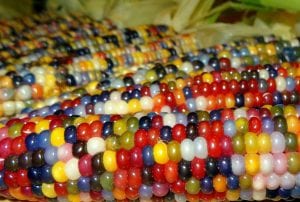Start Organizing your Garden Now – Tips from a Professional
Reading time – 5 minutes
My guest blogger is Ron Thiessen of Thiessen Farms .  He has been farming all his life. As a child he worked with his dad and then took over the farm. He sells his produce at markets and has developed a Community Supported Agricultural Program (CSA) of over 200 families who buy a share of his crops and pick up their produce every week at his farm from May to October. He is located in Jordan Station, Ontario , Canada. He has written on organizing your seeds, choosing your crops and charting their progress.
He has been farming all his life. As a child he worked with his dad and then took over the farm. He sells his produce at markets and has developed a Community Supported Agricultural Program (CSA) of over 200 families who buy a share of his crops and pick up their produce every week at his farm from May to October. He is located in Jordan Station, Ontario , Canada. He has written on organizing your seeds, choosing your crops and charting their progress.
Crop Planning and Choosing Seeds
Brad’s Atomic Grape Tomato
“Elongated cherries in clusters. The colour (and flavor!) is a full-blown assault on the senses – lavender and purple stripes when immature, turning to technicolor olive-green, red, and brown/blue stripes when fully ripe. Really wild! … this amazing variety a good candidate for market growers …” (from www.rareseeds.com)
When we saw this new tomato in a seed catalogue it immediately became a must grow variety for Thiessen Farms in 2017. It looks and sounds amazing!
And when we found seed for the hottest-of-hot peppers – Ghost, Carolina Reaper & Trinidad Scorpion – there was no doubt that they would be on the list too, along with Glass Gem corn, Superschmelz kohlrabi and Golden Wa Wa cabbage.
- Golden Wa Wa cabbage
I’ll admit it. We’re suckers for a cool sounding name and a fancy description. That’s why our seed list has grown to more than 450 varieties of over 60 different vegetables and herbs. But it’s really a cheap thrill. For a few bucks we get to try something new. Sometimes it will turn out great and become a favourite. Other times it’s a disappointment and we never grow it again. But it’s always fun experimenting!
The first week in January is always seed ordering time. We pour over the seed catalogues devouring the particulars of all the vegetables, herbs & flowers, choosing the varieties we will grow in the upcoming season. The selection of seeds is overwhelming making it a delightful yet daunting task.
Here’s how we make our choices …
1. We know what we grew in previous years.
We keep a master list – a spreadsheet that names each crop and variety we grew last season, the amount of seed we have on hand, the year purchased, the company it came from, and the number of days from seeding until harvest. This gives us someplace to start. When the seeds are ordered, all this data is updated & any new varieties are added and those we will not be growing are eliminated.
2. We keep good records – an awful lot of records.
We have a chart where we record every seed we sow in the greenhouse – the date we seeded, the amount, the date the first seeds poked up through the soil, the date we transplanted them and how many, and a spot for random comments. We have more charts where we record everything that gets planted out in the fields – whether it is direct seeded or transplanted from the greenhouse, the variety, the amount, the date. Throughout the growing season we make written notes – both quick observations that we jotted down on the run and more formal evaluations of the different vegetables and how they grew, and produced, their yields, taste, plant health … Photographs are also very helpful for this and so easy to take with cellphones. We find these records invaluable and refer back to them often.
3. As commercial growers we look to our customers for information
What crops sold well and which ones did not, what caught the customers attention, what vegetables are they asking for … We have more charts. For each day at the farmers’ market we record what we brought, how much we sold, the prices and the weather for the day. There are similar charts for each Community Support Agricultural Program (CSA )pick-up. These give us a clear picture of what to grow and how much based on actual sales.
4. What would be fun and interesting to grow!
We always try to grow something new that we have not done before. Recent examples include kalettes , cauliflower artichokes and fava beans.
The seeds are arriving almost daily now
Close to 500 packets of seeds – different sized envelopes, some paper, some foil, even a cloth bag or two, and at least one larger 25 pound sack (snow peas). Add in any leftover seeds from other years, various jars of seed that I saved myself, and we end up with well over 600 different containers of seeds.That’s a lot of seed to deal with and to keep organized!
Proper storage is necessary to keep the seeds viable
Cool and dry storage being the most important conditions. We keep the seeds in our workshop in small, plastic shoe boxes. A label on the lid notes what seeds are inside. These plastic boxes are then stored in larger plastic bins all with secure lids. This keeps them dry, clean & safe from curious animals (ie cats, or even mice – in case the cats are not doing their job!).And there the seeds wait until it’s time to plant them.
What have you learned from Ron Thiessen a commercial grower that will help you to organize your garden this year?
 Julie Stobbe is a Trained Professional Organizer and Lifestyle Organizing Coach who brings happiness to homes and organization to offices, coaching you virtually using Zoom. She has been working with clients since 2006 to provide customized organizing solutions to suit their individual needs and situations. She uses her love of teaching to reduce clutter, in your home and office. She guides and supports you in managing your time. If you’re in a difficult transition Julie can coach you to break-free of emotional clutter constraining you from living life on your terms. Online courses are available to help instruct, coach and support your organizing projects. Get started by downloading Tips for Reorganizing 9 Rooms.
Julie Stobbe is a Trained Professional Organizer and Lifestyle Organizing Coach who brings happiness to homes and organization to offices, coaching you virtually using Zoom. She has been working with clients since 2006 to provide customized organizing solutions to suit their individual needs and situations. She uses her love of teaching to reduce clutter, in your home and office. She guides and supports you in managing your time. If you’re in a difficult transition Julie can coach you to break-free of emotional clutter constraining you from living life on your terms. Online courses are available to help instruct, coach and support your organizing projects. Get started by downloading Tips for Reorganizing 9 Rooms.
Contact her at julie@mindoverclutter.ca
X – Facebook – Facebook group Organizing Mind and Space







This is helpful as I never know what to grow or how to keep track. Thank you for the insight!
They have a very interesting operation where some seeds are started in a small greenhouse inside a medium greenhouse inside a larger greenhouse. I find it fascinating how complex it is to grow the food we eat.